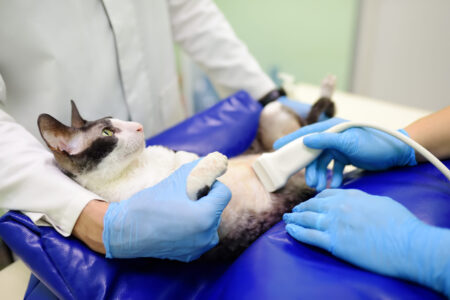Pet overpopulation is a widespread issue that continues to affect countless animals across the world. To combat this problem, animal welfare organizations and pet supply companies like PetSmart have implemented spay and neuter programs to help control the population of stray and unwanted pets. For pet owners, these procedures not only prevent unwanted litters but also have numerous health benefits for their furry companions.
PetSmart is one of the largest pet supply retailers in the United States and has partnered with local animal shelters and clinics to provide affordable and accessible spay and neuter services for pet owners. In this article, we will delve into everything you need to know about PetSmart’s spay and neuter program, from the reasons behind its implementation to the benefits and process of the procedure. Whether you are a pet owner looking to spay or neuter your furry friend, or simply curious about the importance and impact of these procedures, this article will provide you with a comprehensive overview of PetSmart’s spay and neuter program.
PetSmart Spay and Neuter: Everything You Need To Know
PetSmart Spay and Neuter is a widely available service provided by the popular pet supply chain, PetSmart. It is a surgical procedure for sterilizing cats and dogs to prevent them from reproducing. This service exists to help control the pet population and reduce the number of homeless animals in shelters.
The spay and neuter procedure involves removing the reproductive organs of the animal, making them unable to reproduce. This can also have health benefits for the animal, such as reducing the risk of certain cancers and behavioral issues.
PetSmart offers affordable spay and neuter services for both cats and dogs of various ages and sizes. These services are provided by licensed veterinarians in their in-store clinics. They also offer special packages for puppies and kittens, making it easier for pet owners to spay and neuter their pets at a young age.
In addition to the actual procedure, PetSmart also provides educational resources for pet owners to understand the importance of spaying and neutering and how it can benefit both their pets and the community. They also partner with local animal welfare organizations and offer grants to help support their spay and neuter initiatives.
What Is Spaying And Neutering?
Spaying and neutering are surgical procedures performed on cats, dogs, and other animals to remove their reproductive organs. Spaying refers to the removal of a female animal’s uterus and ovaries, while neutering refers to the removal of a male animal’s testicles.
The primary purpose of spaying and neutering is to prevent unwanted pregnancies and reduce the overpopulation of animals. These procedures also offer several health benefits for the animal, including reducing the risk of certain types of cancer and eliminating behaviors associated with mating, such as roaming, spraying, and aggression.
Spaying and neutering are typically recommended for pet animals, but they can also be performed on stray or feral animals to control their populations and improve their overall health.
Does PetSmart Offer Spay And Neuter Services?
Yes, PetSmart does offer spay and neuter services through its in-store veterinary clinics, which are located in select stores across the United States. These clinics offer a range of services, including spay and neuter procedures, vaccinations, and general wellness care. In addition, PetSmart also offers a low-cost spay and neuter program for qualifying pet parents. This program is designed to make spay and neuter procedures more affordable and is available through participating shelters and rescue organizations. To find out more about the services offered by PetSmart, visit their website or contact your local store.
Is Neutered The Same As Spayed?
No, neutered and spayed are not the same thing. Neutering is a procedure that is performed on male animals, while spaying is a procedure that is performed on female animals. During a neutering procedure, the testicles are removed, which prevents the animal from reproducing. During a spaying procedure, the ovaries and uterus are removed, which also prevents the animal from reproducing. Neutering and spaying are both considered to be routine surgeries, and they are typically performed when the animal is young. In most cases, the animal will recover quickly and can resume normal activities within a few days.
Can A Dog Be Spayed Without Surgery?
While it is not possible to spay a dog without surgery, some alternatives may be considered in certain situations. One option is a procedure called tubal ligation, which involves blocking the fallopian tubes to prevent the release of eggs. This procedure is not as common as traditional spaying, but it may be an option for dogs who are at high risk for anesthesia or surgery. Another option is a procedure called ovariectomy, which involves removing the ovaries while leaving the uterus intact. This procedure can be performed through a laparoscopic approach, which is less invasive than traditional spaying.
How Long Does A Spay Take To Heal?
The healing process after a spay surgery can vary depending on the dog’s age, size, and overall health. Generally, it takes about 10 to 14 days for the incision to heal completely. During this time, it is important to keep the incision clean and dry and to follow your veterinarian’s instructions for post-operative care. In most cases, the dog will be able to resume normal activity within a few days after surgery, but strenuous activity should be avoided until the incision is fully healed. During the healing process, it is also important to watch for signs of infection or other complications.
Benefits of Spaying And Neutering At Petsmart
- Prevents unwanted pregnancies: Spaying and neutering help prevent unwanted pregnancies in pets, reducing the number of animals that end up in animal shelters or on the streets.
- Promotes healthier pets: Spaying and neutering can help reduce the risk of certain health issues in pets, such as certain types of cancers and infections of the reproductive organs.
- Reduces behavioral problems: Spaying and neutering can also help reduce certain behavioral problems in pets, such as marking, aggression, and roaming.
- Saves money: By spaying or neutering your pet at Petsmart, you can save money in the long run on potential medical bills for health issues that can arise in unaltered pets.
- Supports animal welfare: By choosing to spay or neuter your pet at Petsmart, you are supporting their efforts to reduce pet overpopulation and improve the well-being of animals.
- Convenient and affordable: Petsmart offers convenient and affordable spay and neuter services, making it easier for pet owners to access this important procedure for their pets.
- Faster recovery time: Petsmart uses state-of-the-art technologies and techniques for spaying and neutering, which can help reduce the recovery time for pets after the procedure.
- Discounts for adopted pets: Petsmart offers discounted spay and neuter services for pets adopted from animal shelters and rescue organizations, making it easier for owners to provide vital care for their new pets.
- Community impact: By spaying and neutering your pet at Petsmart, you are also contributing to the overall reduction of stray and feral animals in your community.
- Peace of mind: By spaying or neutering your pet, you can have peace of mind knowing that you are taking responsible steps to improve your pet’s health and well-being, as well as contributing to the betterment of the animal community as a whole.
Cost Of Spaying And Neutering At Petsmart
The cost of spaying and neutering at PetSmart will vary depending on the location of the store, the age and weight of the animal, and any additional services that are performed during the procedure. Generally, the cost of spaying a female dog ranges from $150 to $300, while the cost of neutering a male dog ranges from $100 to $250. In addition to the cost of the procedure itself, additional costs may include pre-operative blood work, pain medications, and the cost of an e-collar or cone to prevent the animal from licking the incision. These additional costs can vary depending on the specific clinic
What To Expect During Your Petsmart Spay And Neuter Appointment

Cat having ultrasound scan in veterinary clinic. Health of pet. Care animal. Pet checkup, tests and vaccination in vet office.
The most convenient and popular place to have your pet spayed or neutered is at Petsmart, so here is what you can expect during your pet’s appointment.
- Pre-Surgical Preparation
Before the appointment, your pet will need to fast for at least 12 hours. This means no food after midnight on the night before the surgery. Water can be given in small quantities until you bring your pet to the clinic. It’s important to follow fasting instructions, as a full stomach can increase the risk of anesthesia and complications during surgery. Additionally, your pet will need to have a current rabies vaccination and should be up-to-date on other required vaccinations.
- Pre-Operative Exam and Check-In
When you arrive at the clinic on the day of the appointment, you will check in with the receptionist and fill out any necessary paperwork. You will also be asked to provide your pet’s medical history, including any medications or supplements they are currently taking. Your pet will then be brought to the exam room for a pre-operative exam. During this time, the veterinarian will perform a physical exam to ensure your pet is healthy enough for surgery.
- Anesthesia
Once the pre-operative exam is complete, your pet will be given an injection of anesthesia to put them into a deep sleep. This will allow the veterinarian to perform the surgery without causing any pain or discomfort to your pet. The type of anesthesia used will depend on your pet’s health and age, and it will be tailored to their specific needs.
- Surgery
The surgical procedure will then begin. For females, the veterinarian will make a small incision in the abdomen and remove the uterus and ovaries. For males, the veterinarian will make an incision near the scrotum and remove the testicles. The incision will then be closed with stitches. Both procedures are relatively quick and usually take less than 30 minutes.
- Recovery and Post-Operative Care
After surgery, your pet will be closely monitored as it wakes up from the anesthesia. It is normal for them to be groggy and disoriented, but you should be able to take them home the same day. Your pet may experience some discomfort and will need to limit their activity for a few days as they heal. You will be given post-operative care instructions, including how to care for the incision site and when to schedule a follow-up visit.
- Cost
The cost of spaying and neutering at Petsmart varies depending on the type and size of your pet. It can range from $45-$200 for a cat and $90-$350 for a dog. Additional services, such as vaccinations or pain medication, may also incur an extra cost. It’s best to check with your local Petsmart clinic for exact pricing.
SEE ALSO: Home Remedy for Dog Itchy Bum
Post-Operation Care For Spay And Neuter Surgery
- Monitor the Incision Site: Keep an eye on the incision site for any signs of redness, swelling, or discharge, which could indicate an infection.
- Limit Activity: Make sure your pet rests and avoids any strenuous activity for at least 7-10 days after surgery. This will allow the incision to heal properly.
- Do Not Let Them Lick or Chew: It’s important to prevent your pet from licking or chewing at the incision site. This can irritate and delay healing. You can use an Elizabethan collar or bitter apple spray to discourage licking.
- Watch for Signs of Pain: It’s common for pets to experience some pain after surgery. Watch for signs such as restlessness, whining, or reluctance to move. If your pet seems uncomfortable, consult with your vet about pain management options.
- Follow Medication Instructions: Your vet may prescribe pain medication or antibiotics for your pet. Follow the instructions carefully and give the medication as directed.
- Keep the Incision Clean: Keep the incision site clean and dry to prevent infection. If your vet recommends cleaning the area, use a mild soap and warm water, and pat the area dry.
- Follow the Recommended Diet: Your vet may recommend a special diet for your pet after surgery to support healing. Follow their recommendations for the best results.
- Make Sure Your Pet is Drinking and Eating: Your pet needs to stay hydrated and maintain a normal appetite after surgery. If your pet is not drinking or eating as usual, contact your vet.
- Avoid Bathing: Do not bathe your pet for at least 10-14 days after surgery. This will give the incision site time to heal and reduce the risk of infection.
- Go to Follow-Up Appointments: Your vet will likely schedule a follow-up appointment to check on your pet’s healing. Make sure to attend these appointments and report any concerns you may have.
By following these post-operative care tips, you can help ensure a smooth and successful recovery for your pet after their spay or neuter surgery. If you have any questions or concerns, do not hesitate to contact your vet for guidance.
SEE ALSO: Comparing PetSmart Vaccination Prices To Find The Best Value
FAQs
Q. What do female dogs need during spay recovery?
A. The recovery process after a spay surgery is relatively simple, but there are a few things that female dogs may need during this time. First, it is important to keep the incision clean and dry. This can be done by gently wiping the area with a clean, soft cloth and avoiding baths or swimming until the incision has healed. Second, it is important to limit activity during the first week or two after surgery. This means no running, jumping, or playing fetch. Finally, it is important to make sure the dog gets plenty of rest and has a quiet place to recover.
Q. What age is best for spay and neuter?
A. The ideal age for spaying and neutering can vary depending on the breed and size of the dog. However, most veterinarians recommend that dogs be spayed or neutered when they are between 4 and 6 months old.
Q. What to expect after your pet is spayed or neutered?
A. After a pet is spayed or neutered, it is important to expect some behavioral and physical changes. These changes can vary depending on the pet’s age, breed, and sex. Generally, though, most pets will experience some level of lethargy and fatigue in the first few days after surgery. This is normal and should be resolved within a week.
Conclusion
In conclusion, PetSmart Spay and Neuter is a valuable program that offers comprehensive services to pet owners looking to spay or neuter their pets. Not only does it help control the overpopulation of pets, but it also has numerous benefits for the health and behavior of animals. Through their partnerships with local veterinarians and affordable pricing, PetSmart makes it easy for pet owners to access these services. It is highly recommended that all pet owners educate themselves on the importance of spaying and neutering and consider utilizing PetSmart’s program for the well-being and longevity of their furry companions.


